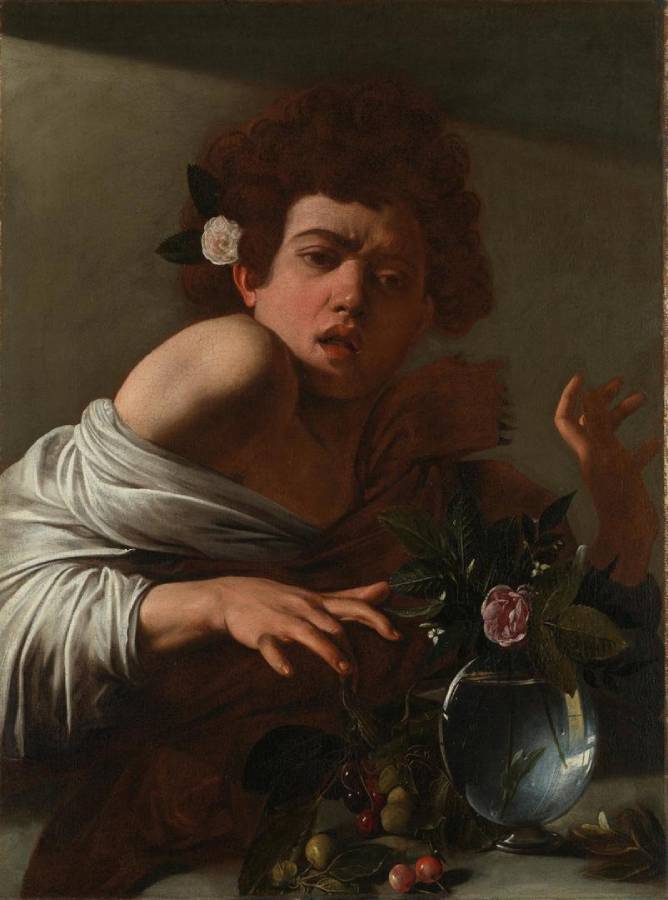Caravaggio (1571-1610)
Ragazzo morso da un ramarro (Boy bitten by a Lizard)
c.1594–1595
Oil on canvas, 66 x 49.5 cm
National Gallery, London
An effeminate youth with curling locks, full lips and a rose tucked behind one ear, recoils in surprise at being bitten by a lizard, which clings tenaciously to his finger. With a startled expression etched across his face, the boy is caught mid-motion, snatching his hand away from the unexpected pain. In the foreground is a magnificent still life of cherries and plums, with a rose and sprig of jasmine arranged in a glass vase. Look closely and you can see the reflection of a room in the curved surface of the vase.
The precise meaning of this striking image is not clear, though it may be allegorical. The scene might refer to the pain that can derive from love – a warning against the perils of love and the unexpected dangers that lurk behind beautiful things. It could be intended as a vanitas, with the rose symbolising the transience of life and beauty, or perhaps one of the senses (Touch). It might equally be a study in extreme expression, whether copied from a live model or (as some have suggested) from a mirror image of the artist himself. It is certainly very unusual for a late sixteenth-century painting to show such a moment of action, but Caravaggio was anything but conventional. He painted directly onto the canvas from live models, without preparing numerous studies on paper beforehand, and this innovative practice set him apart from classicising artists such as Annibale Carracci. Skipping a whole stage in the traditional artistic process was highly controversial, but it gave Caravaggio’s works an immediacy and intensity which made them instantly popular.
This picture is the earliest of our three Caravaggios – the others being The Supper at Emmaus and Salome receives the Head of John the Baptist. It was probably painted in the mid-1590s in Rome, where Caravaggio had moved to as a young man, initially specialising as a painter of still lifes in other artists’ studios. Still-life painting was considered inferior to figure painting in Caravaggio’s own day, but he elevated the depiction of fruit and flowers to new heights, declaring that painting objects required as much artistry as painting figures. Here Caravaggio’s still life is placed prominently in the foreground, as the artist transforms the boy’s impulsive movement into a narrative drama. It was highly compelling and innovative paintings such as this, rooted in the world around him, that brought Caravaggio to the attention of influential patrons such as Cardinal Francesco Maria del Monte, in whose household the artist resided from 1595.
Caravaggio’s biographers describe a painting of a boy being bitten by a lizard and it was almost certainly made for the open market, without a specific patron in mind. At around the same time he produced a number of works showing everyday subjects – youths, musicians, lute players, cardsharps and fortune tellers – the originality and popularity of which led to increasing demand among collectors and countless imitations. Numerous early seventeenth-century copies and derivations of Boy bitten by a Lizard exist, including a high-quality replica in the Fondazione Longhi, Florence, considered by many to be by Caravaggio himself. (NG)
